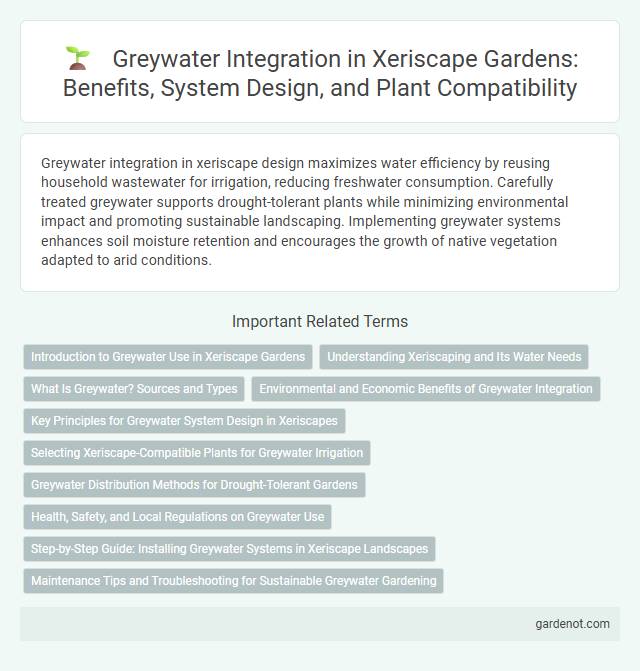Greywater integration in xeriscape design maximizes water efficiency by reusing household wastewater for irrigation, reducing freshwater consumption. Carefully treated greywater supports drought-tolerant plants while minimizing environmental impact and promoting sustainable landscaping. Implementing greywater systems enhances soil moisture retention and encourages the growth of native vegetation adapted to arid conditions.
Introduction to Greywater Use in Xeriscape Gardens
Greywater integration in xeriscape gardens enhances water efficiency by reusing household wastewater from sinks, showers, and laundry for irrigation purposes. This sustainable practice reduces reliance on potable water while promoting healthy plant growth in arid landscapes. Proper treatment and distribution systems ensure safe application, supporting drought-tolerant plants and conserving valuable water resources.
Understanding Xeriscaping and Its Water Needs
Greywater integration in xeriscaping maximizes water efficiency by reusing household wastewater for irrigation, significantly reducing freshwater consumption. Xeriscaping emphasizes drought-tolerant plants and soil improvement to minimize irrigation needs, making greywater a sustainable solution to meet these reduced water demands. Understanding the specific water requirements and treatment levels of greywater ensures safe and effective reuse within xeriscape landscapes.
What Is Greywater? Sources and Types
Greywater refers to gently used water from household sources such as sinks, showers, bathtubs, and washing machines, excluding sewage or toilet discharge, which is classified as blackwater. Common types of greywater include laundry water, bathwater, and kitchen sink runoff, with varying levels of contaminants depending on the source. Incorporating greywater in xeriscape landscaping efficiently recycles water, reducing the demand on potable water supplies while promoting sustainable irrigation practices.
Environmental and Economic Benefits of Greywater Integration
Greywater integration in xeriscaping significantly reduces freshwater consumption by recycling household water for irrigation, promoting sustainable water management. This practice lowers water bills and decreases demand on municipal water supplies, resulting in substantial economic savings. Environmentally, it reduces wastewater discharge and minimizes the strain on aquatic ecosystems, enhancing overall ecosystem health.
Key Principles for Greywater System Design in Xeriscapes
Effective greywater integration in xeriscapes hinges on key principles such as the use of low-flow fixtures to minimize nutrient overload and the implementation of subsurface irrigation to prevent surface runoff and evaporation. Proper filtration and treatment systems ensure the removal of contaminants, safeguarding plant health and soil quality while adhering to local regulations. Designing greywater systems with native drought-tolerant plants maximizes water reuse efficiency and promotes sustainable landscaping practices.
Selecting Xeriscape-Compatible Plants for Greywater Irrigation
Selecting xeriscape-compatible plants for greywater irrigation involves choosing drought-tolerant species that thrive with recycled water containing minimal salts and nutrients. Native succulents, ornamental grasses, and Mediterranean herbs like lavender and rosemary demonstrate high resilience to greywater conditions while reducing water consumption. Proper plant selection enhances sustainability by minimizing fertilizer needs and preventing soil salinization in greywater-irrigated xeriscapes.
Greywater Distribution Methods for Drought-Tolerant Gardens
Greywater distribution methods for drought-tolerant gardens include subsurface drip irrigation, surface drip irrigation, and mulch basin systems, each designed to maximize water efficiency while minimizing evaporation and runoff. Subsurface drip irrigation delivers greywater directly to plant root zones, promoting deep soil absorption and reducing surface moisture that can lead to fungal growth. Mulch basin systems capture and slowly release greywater into the soil, enhancing moisture retention and supporting the health of drought-tolerant plants like succulents and native shrubs.
Health, Safety, and Local Regulations on Greywater Use
Greywater integration in xeriscape designs requires strict adherence to health and safety standards to prevent contamination and ensure safe irrigation practices. Local regulations often mandate treatment and usage guidelines, such as restricting greywater application to subsurface irrigation and prohibiting direct contact with edible plants. Compliance with government codes, like the EPA and state-specific water quality standards, is essential to safeguard public health while optimizing water reuse.
Step-by-Step Guide: Installing Greywater Systems in Xeriscape Landscapes
Installing greywater systems in xeriscape landscapes begins with assessing household water sources such as laundry or bathroom sinks to ensure suitability and safety for irrigation use. Next, design a plumbing layout that diverts greywater through filters to prevent solids from clogging the irrigation pipes, focusing on drip emitters or subsurface applications to minimize evaporation. Finally, monitor system performance regularly by checking for leaks, maintaining filter cleanliness, and adjusting irrigation schedules to optimize water conservation while supporting drought-tolerant xeriscape plants.
Maintenance Tips and Troubleshooting for Sustainable Greywater Gardening
Effective maintenance of greywater systems in xeriscape gardens includes regularly checking filters and pumps to prevent clogs and ensure proper flow. Inspecting irrigation emitters and soil moisture levels helps avoid overwatering and salt buildup, protecting drought-tolerant plants. Troubleshooting common issues like odors or discoloration involves adjusting nutrient balances and flushing the system periodically to maintain sustainable greywater recycling.
Greywater integration Infographic

 gardenot.com
gardenot.com